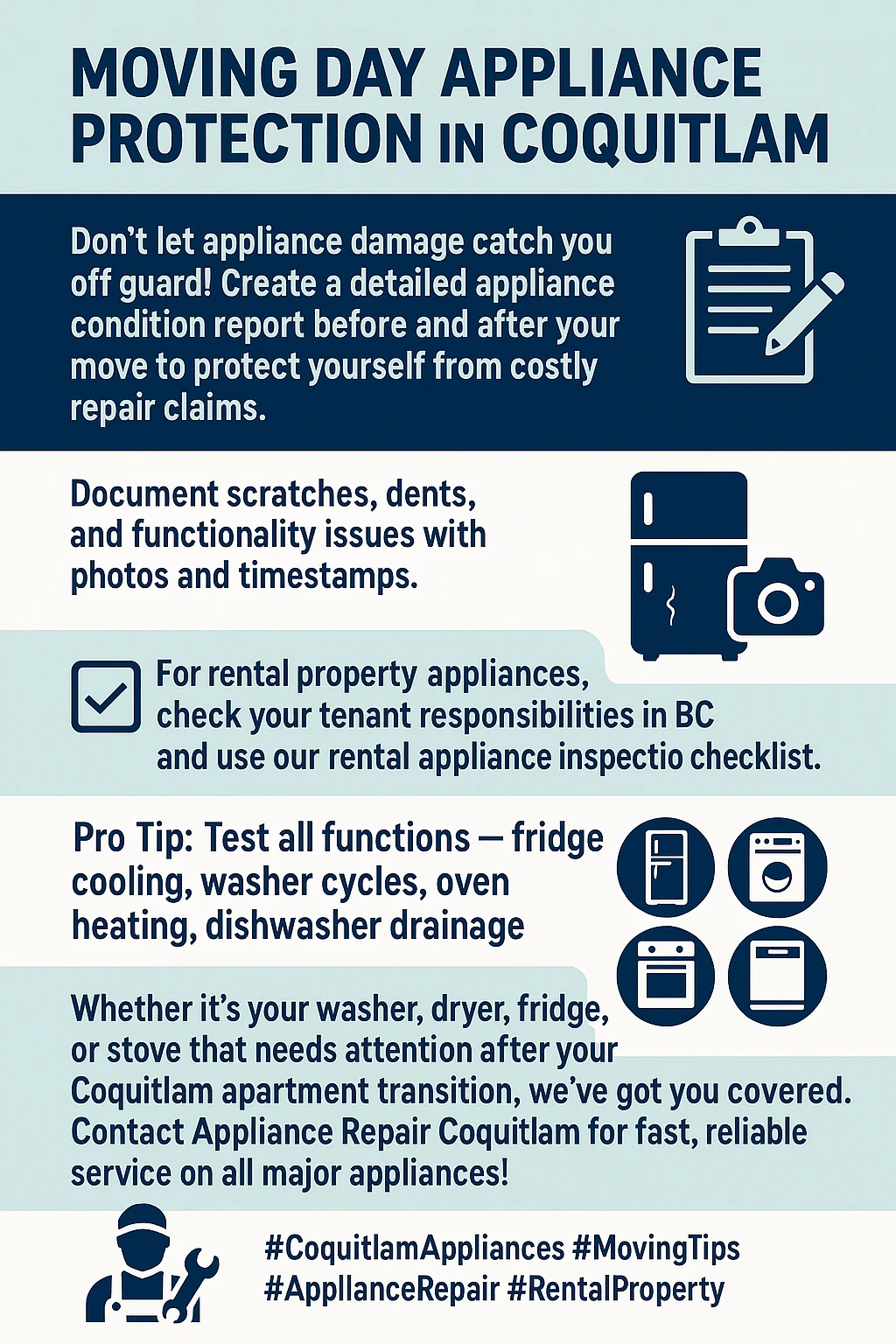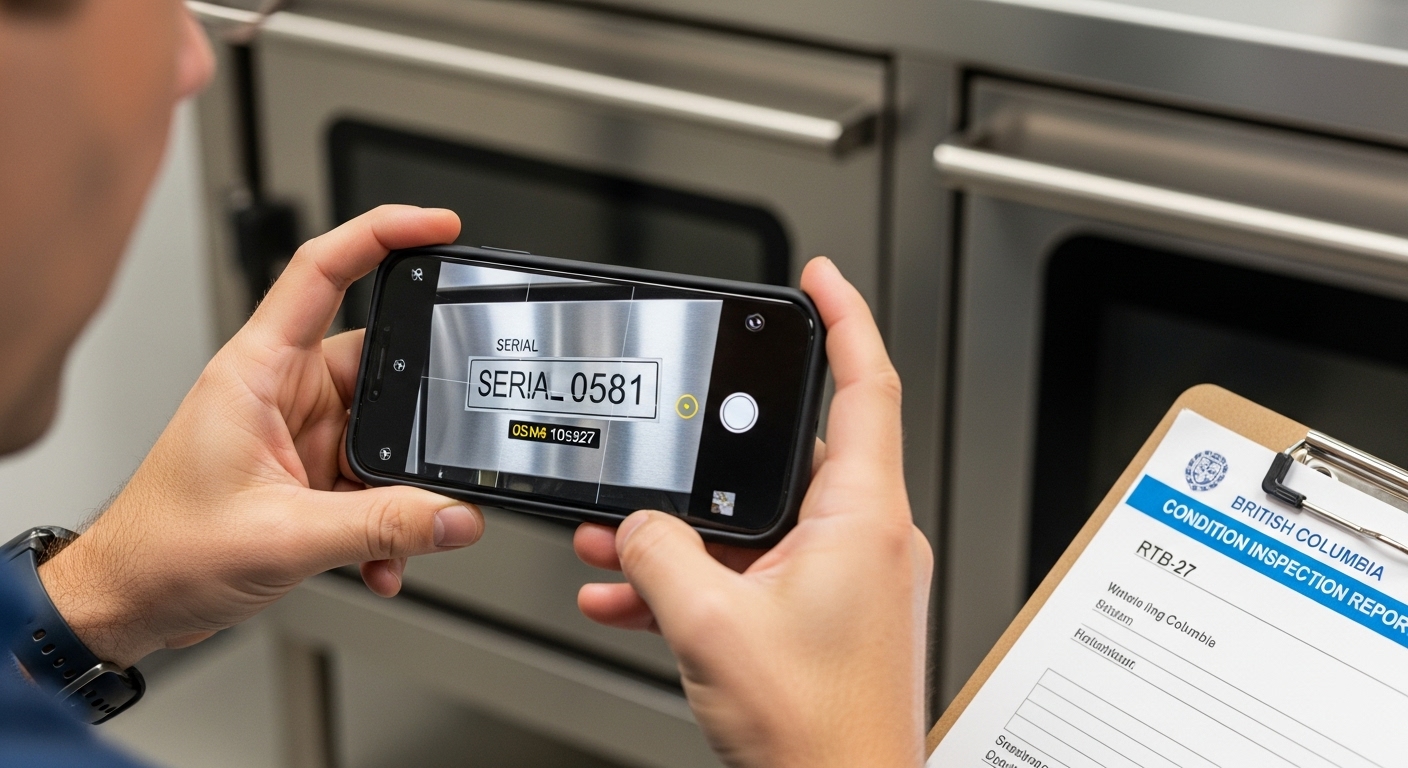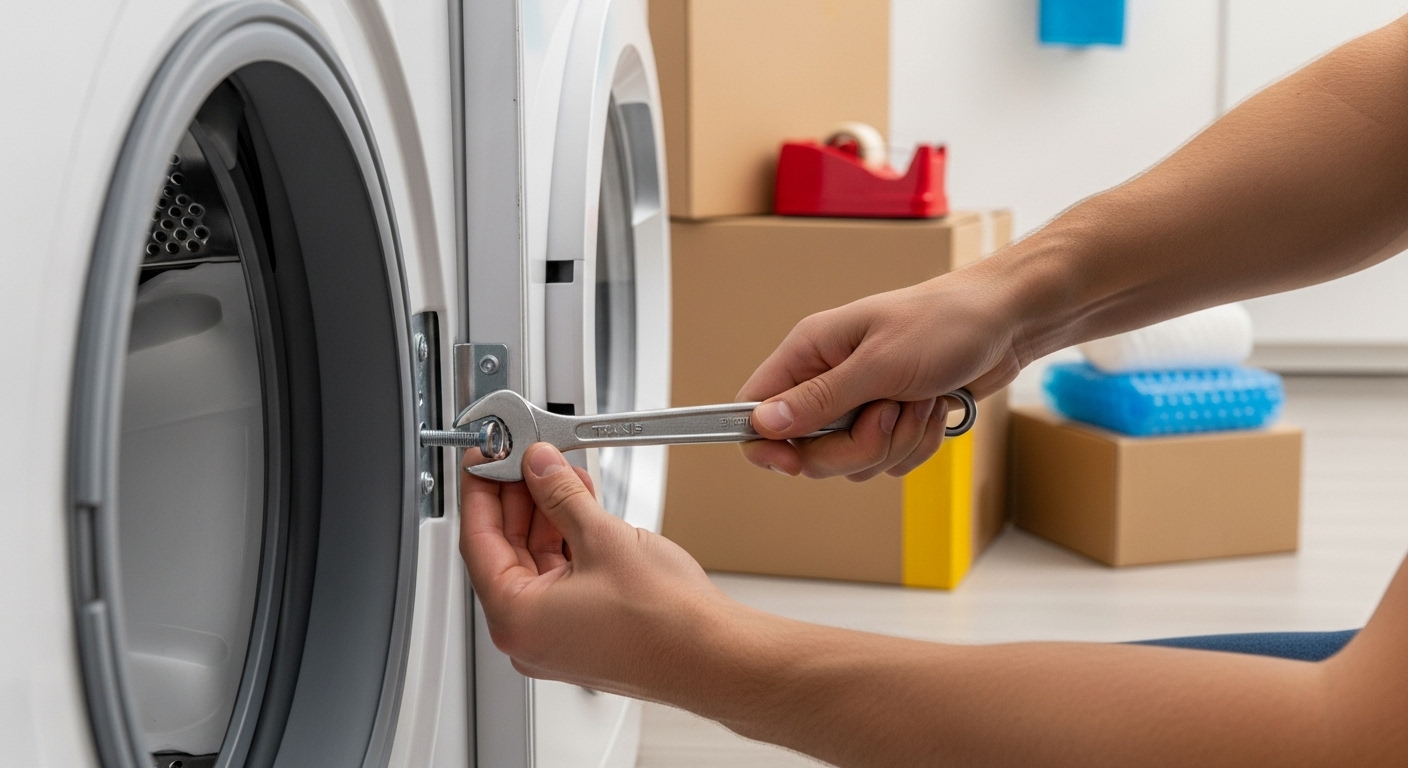Planning your next Coquitlam apartment move but worried about expensive appliance damage wiping out your security deposit? Every month, BC renters lose thousands of dollars to preventable appliance mishaps during apartment transitions, but smart documentation and proper moving techniques can protect both your wallet and your tenant rights.
Picture this scenario: you’re doing your move-out inspection with your landlord in Coquitlam, excited about getting your full security deposit back, when suddenly they point at your refrigerator and claim the door seal is damaged. They’re demanding $400 from your deposit for repairs, but you’re certain the fridge was working fine when you moved in two years ago. Without proper documentation from your move-in inspection, you’re stuck in a he-said-she-said situation that could cost you hundreds of dollars. This exact scenario plays out countless times across Metro Vancouver, leaving both tenants and landlords frustrated and financially strained.
The good news is that BC’s Residential Tenancy Act provides clear frameworks for protecting both parties, but only if you understand your rights and document everything properly. From the mandatory condition inspection reports to the specific settling requirements for different appliances, there are proven strategies that can prevent 90% of appliance-related disputes during apartment transitions. Whether you’re moving within Coquitlam’s hillside neighborhoods or relocating from Vancouver to the Tri-Cities area, this guide will walk you through the complete process of protecting your appliances and your security deposit.
With appliance repair costs in the Vancouver area ranging from $100-$230 just for diagnostic visits, and major repairs like compressor replacements costing up to $1,500, understanding prevention is far more cost-effective than dealing with damage after it occurs. Let’s dive into the essential strategies every Coquitlam renter needs to know.
Key Outtakes:
- BC landlords are legally responsible for maintaining appliances included in tenancy agreements, while tenants must report issues promptly and avoid misuse
- Professional appliance moving requires 24-48 hours of preparation including defrosting, cleaning, and proper disconnection to prevent damage during Coquitlam moves
- Documenting appliance condition with timestamped photos and signed inspection reports at move-in protects both tenants and landlords from disputes over security deposits
- Refrigerators and freezers must remain upright during transport and settle for 4-24 hours before plugging in to prevent compressor damage
- Coquitlam’s coastal climate requires additional moisture protection during appliance relocation due to condensation risks during temperature transitions

Understanding Tenant and Landlord Appliance Responsibilities in BC
Before diving into moving strategies, you need to understand exactly who’s responsible for what when it comes to rental property appliances in British Columbia. The legal framework isn’t always intuitive, and many disputes arise from simple misunderstandings about responsibilities. Under BC’s Residential Tenancy Act, responsibility splits depend on several factors including what’s written in your tenancy agreement, the cause of the problem, and the timing of when issues occur.

Landlords have a clear legal obligation to maintain rental properties to health, safety, and housing standards, which includes any appliances specifically listed in your tenancy agreement. As BC’s official guidance states, landlords are responsible for regular repairs and maintenance, but are not responsible for damage caused by tenants, their pets, or guests. This means if your refrigerator stops working due to normal wear and tear or mechanical failure, that’s the landlord’s responsibility. However, if it breaks because you moved it incorrectly or used it improperly, you could be on the hook for repair costs.
The distinction between normal wear and tear versus tenant-caused damage becomes crucial during apartment transitions. Age-related mechanical failures, environmental factors like BC’s coastal humidity affecting appliance performance, and routine component wear all fall under landlord responsibility. However, tenants must fulfill their part of the bargain by using appliances according to manufacturer guidelines, reporting issues promptly in writing, and allowing reasonable access for repairs. The key is understanding that proper appliance handling during moves directly affects who pays when something goes wrong.
Coquitlam renters have additional protections through the city’s Tenant Relocation Policy, which requires moving compensation of $750 for studio and one-bedroom units or $1,000 for two-bedroom units when landlords initiate moves for redevelopment. This policy recognizes that proper appliance relocation has real costs and provides financial support to help tenants hire professional services that reduce damage risks. Understanding these protections empowers you to make informed decisions about DIY versus professional moving services.
The Essential Rental Appliance Inspection Checklist
Creating a bulletproof documentation system starts with understanding BC’s official requirements for condition inspections. Every tenancy in BC must begin and end with a completed Condition Inspection Report (RTB-27), and this document becomes your primary defense against unfair security deposit deductions. The inspection process isn’t just a formality – it’s a legal requirement that protects both tenants and landlords by establishing baseline conditions that can be referenced if disputes arise.

BC’s official inspection form specifically lists appliances that must be documented, including refrigerator components like crisper drawers, shelves, freezer, door and exterior condition, plus stove/stove top, oven, exhaust hood and fan, dishwasher, and washer/dryer if provided. For each appliance, you’ll use condition codes: G for Good, F for Fair, P for Poor, D for Damaged, S for Scratched, B for Broken, M for Missing, DT for Dirty, and ST for Stained. Don’t rush through this process – taking time to properly assess each appliance can save you hundreds later.
Beyond the official form, create your own supplementary documentation system that includes model and serial numbers for each appliance, timestamped photographs from multiple angles showing any existing damage, functional testing results noting any unusual sounds or performance issues, and video documentation of appliances in operation. Email these photos to your landlord and request confirmation of receipt – having proof they received your documentation adds another layer of protection. Store all documentation in cloud storage for long-term access and easy retrieval during move-out inspections.
The digital documentation process becomes especially important for appliances with glass surfaces, stainless steel finishes, or visible wear patterns that might be disputed later. Take wide shots showing overall condition and close-up shots of any scratches, dents, or discoloration. Test every function – every burner on the stove, all refrigerator and freezer temperature zones, each dishwasher cycle, and both wash and dry functions for laundry appliances. This thorough approach as outlined in professional rental inspection guides creates an unassailable record of pre-existing conditions.
Preventing Appliance Damage During Moving Day in Coquitlam
Successful appliance moving begins well before the moving truck arrives, and timing is absolutely critical for preventing damage that could cost you hundreds in repair bills. The biggest mistake Coquitlam renters make is waiting until moving day to start preparing their appliances, but proper preparation requires a structured 48-hour timeline that accounts for defrosting, cleaning, disconnection, and climate considerations unique to BC’s coastal environment.

Start your preparation 48 hours before moving day with the most time-sensitive task: defrosting refrigerators and freezers. This process alone can take 24 hours depending on ice buildup, and rushing it leads to water damage, mold issues, and potential electrical problems. Remove all food items and consume or donate perishables rather than letting them spoil. Once defrosting begins, clean all interior surfaces with baking soda and warm water, remove all shelves and drawers for separate packing, and prop doors open with towels to maintain airflow and prevent mold growth during the defrosting process.
Washing machines present their own unique preparation challenge that most renters don’t understand: transit bolts. These specialized bolts secure the washing machine’s internal drum during transport, preventing damage to the suspension system that could cost $500-900 to repair. If your washing machine weighs over 200 pounds, transit bolts are absolutely essential – without them, the drum can bounce around inside the machine during transport, causing catastrophic internal damage. If you’ve lost your original transit bolts, order replacements from the